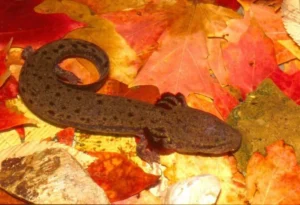Mudpuppies live underwater in lakes, rivers, and ponds. They are strange, quiet creatures that people don’t see often. If you come across a mudpuppy, you might wonder: are mudpuppies salamanders?
Yes, mudpuppies are salamanders, but they are unique because they live underwater their entire lives and keep their gills.
Unlike many salamanders that move from water to land as they grow, mudpuppies never leave the water. They keep their feathery gills, which let them breathe underwater all the time.
Mudpuppies Are Aquatic Salamanders
Mudpuppies belong to the salamander family. Like many salamanders, they start life in water. But unlike most salamanders, mudpuppies never leave the water. They live underwater all their lives.
Most salamanders hatch with gills and live in water for a while. Then they lose their gills, grow lungs, and move to land. Mudpuppies don’t do this. They keep their gills forever and breathe underwater all the time.

Because of this, mudpuppies have bodies built for water life. They have four short legs with webbed toes that help them swim.
Their legs don’t work well for walking on land, so they stay in the water where they can move easily.
Why Are They Called Mudpuppies?
Mudpuppies get their funny name because of the sounds they make. When they move through mud or water, they sometimes let out low growls or barks. These noises remind people of puppies, so the name stuck.
Their muddy brown color helps them blend in with the bottoms of lakes and rivers. This coloring keeps them safe from predators by making them hard to spot.
Where Can You Find Mudpuppies?
Mudpuppies live in freshwater all over parts of North America. They like lakes, ponds, rivers, and streams. They want places with cool, clean water and lots of rocks or plants where they can hide.

Since mudpuppies live underwater all their lives, the quality of the water is very important. Pollution or warm water can make their homes unsafe.
Scientists often look for mudpuppies to check how healthy a body of water is.
What Do Mudpuppies Eat?
Mudpuppies are carnivores, which means they eat meat. They hunt small fish, insects, worms, snails, and other tiny water animals.
Their diet is similar to other salamanders, but since they live underwater all the time, they only eat aquatic creatures.
Mudpuppies have strong jaws and sharp teeth to catch slippery prey. They mostly hunt at night or in hiding, sneaking up on food in plants or under rocks.
How Do Mudpuppies Differ From Other Salamanders?
Most salamanders have a life cycle that begins in water but moves to land when they mature. They start as larvae with gills, then grow lungs to live on land. Mudpuppies don’t do this.
Mudpuppies show what scientists call neoteny. This means they keep their juvenile features (like their gills) into adulthood. They stay in their youthful form, living underwater for life.
Another difference is that mudpuppies don’t have eyelids. They keep their eyes open all the time because they live underwater. Most land salamanders have eyelids and can blink.
Are Mudpuppies Rare or Common?
Mudpuppies aren’t very common, but they’re not extremely rare either. Because they live underwater and are mostly active at night, people don’t see them often. Scientists study them to learn about freshwater ecosystems and amphibian biology.
Since mudpuppies need clean water, their presence can be a sign of a healthy habitat. If mudpuppies disappear from an area, it might mean the water is polluted or damaged.
How Do Mudpuppies Reproduce?
Mudpuppies mate underwater. Unlike land salamanders that often visit water only to lay eggs, mudpuppies spend their entire lives underwater, so mating and egg-laying happen in water.
Females lay eggs on rocks or plants, and the eggs hatch into larvae that look like small mudpuppies. These larvae grow into adults without leaving the water.
Do Mudpuppies Have Any Defenses?
Mudpuppies don’t have many strong defenses. They rely mostly on camouflage to hide from predators. Their muddy colors blend in well with the river and lake bottoms.

If threatened, mudpuppies can sometimes shed their tails to escape, a defense trick many salamanders use. The tail grows back later, but it helps the mudpuppy get away from danger.
Are Mudpuppies Dangerous to People?
Mudpuppies are harmless to humans. They don’t bite unless provoked, and even then, their bite isn’t dangerous. They don’t carry diseases that affect people, and they don’t pose any risk.
Because they live underwater and keep their distance, encounters with mudpuppies are rare. When people catch them accidentally, they usually let them go unharmed.
Can Mudpuppies Be Kept as Pets?
Mudpuppies can be kept as pets, but they require special care. They need cool, clean water and a tank that mimics their natural environment with hiding spots like rocks and plants.
Because mudpuppies live underwater their whole lives, you must keep their water healthy and well-filtered. They can live for many years in captivity if cared for properly.
However, mudpuppies are not common pets. They need specific conditions that can be hard to maintain, so they’re best left to experienced amphibian keepers.
Conclusion
Mudpuppies teach us about the amazing ways animals can live and survive in different places. They show how not all salamanders live on land, some, like mudpuppies, have found a way to stay underwater forever.
Protecting mudpuppies and their homes also helps protect freshwater environments. These ecosystems support many plants and animals, and clean water is important for humans too.
By understanding mudpuppies, we learn more about nature’s variety and how we can help keep it healthy.
Hi, my name is Ezra Mushala, i have been interested animals all my life. I am the main author and editor here at snakeinformer.com.

